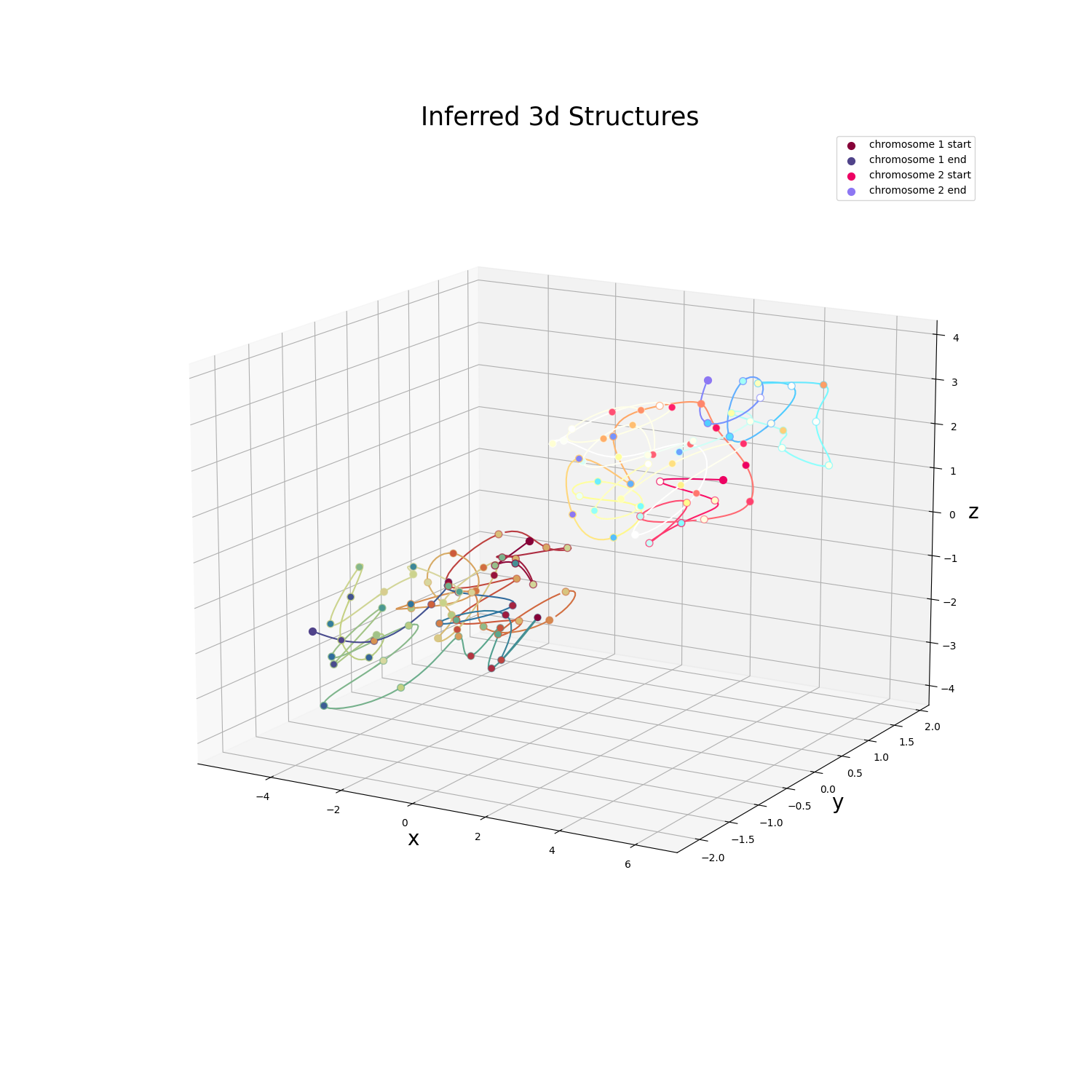
Note
Go to the end to download the full example code. or to run this example in your browser via Binder
This example showcases how to plot an inferred 3D structure output by PASTIS using matplotlib.
import numpy as np
import matplotlib
import matplotlib.pyplot as plt
from mpl_toolkits.mplot3d.art3d import Line3DCollection
from scipy import interpolate
def modify_cmap(function, cmap):
"""Lighten or darken a given colormap.
Applies function (which should operate on vectors of shape 3:
[r, g, b]), on colormap cmap. This routine will break any discontinuous
points in a colormap.
Adapted from:
https://scipy-cookbook.readthedocs.io/items/Matplotlib_ColormapTransformations.html
"""
cdict = cmap._segmentdata
step_dict = {}
# Get the list of points where the segments start or end
for key in ('red', 'green', 'blue'):
step_dict[key] = list(map(lambda x: x[0], cdict[key]))
step_list = sum(step_dict.values(), [])
step_list = np.array(list(set(step_list)))
# Compute the LUT, and apply the function to the LUT
def reduce_cmap(step):
return np.array(cmap(step)[0:3])
old_LUT = np.array([reduce_cmap(x) for x in step_list])
new_LUT = np.array([function(x) for x in old_LUT])
# Try to make a minimal segment definition of the new LUT
cdict = {}
for i, key in enumerate(['red', 'green', 'blue']):
this_cdict = {}
for j, step in enumerate(step_list):
if step in step_dict[key]:
this_cdict[step] = new_LUT[j, i]
elif new_LUT[j, i] != old_LUT[j, i]:
this_cdict[step] = new_LUT[j, i]
colorvector = list(map(lambda x: x + (x[1], ), this_cdict.items()))
colorvector.sort()
cdict[key] = colorvector
return matplotlib.colors.LinearSegmentedColormap('colormap', cdict, 1024)
def interpolate_chromosome(chrom, eps=0.1):
"""Interpolate a smooth line between the beads of a given chromosome.
Should only be run on a single chromosome molecule.
Parameters
----------
chrom : array of float
The 3D structure of a given chromosome (nbeads, 3).
eps : float, optional
Frequency of points to be interpolated. A value of '1' simply replaces any
NaN beads with interpolated values, but does not form a line connecting
between adjacent beads.
Returns
-------
chrom_interp : array of float
The smoothed 3D structure for the given chromosome.
"""
# Select non-NaN beads
mask = np.invert(np.isnan(chrom[:, 0]))
if mask.sum() < 2:
return None # Skip chromosomes with < 2 non-NaN beads
x = chrom[mask, 0]
y = chrom[mask, 1]
z = chrom[mask, 2]
# Get interpolation functions for the x, y, and z coordinates
bead_idx = np.arange(chrom.shape[0])[mask]
f_x = interpolate.Rbf(bead_idx, x, smooth=0)
f_y = interpolate.Rbf(bead_idx, y, smooth=0)
f_z = interpolate.Rbf(bead_idx, z, smooth=0)
# Use interpolation functions to create line segments between adjacent
# coordinate beads
line_idx = np.arange(bead_idx.min(), bead_idx.max() + eps, eps)
chrom_interp = np.array([f_x(line_idx), f_y(line_idx), f_z(line_idx)]).T
return chrom_interp
def plot_chromosome(chrom, ax=None, cmap=None, name=None, bead_size=50):
"""Plot a single chromosome molecule on the supplied axis.
Beads are represented as translucent circles, and a line is interpolated
between adjacent beads. Should only be run on a single chromosome molecule.
Parameters
----------
chrom : array of float
The coordinates of the 3D structure of a given chromosome,
shape=(nbeads_chrom, 3).
ax : matplotlib.axes.Axes object, optional
The matplotlib axis on which to plot the chromosome. If absent, a new
figure will be created.
cmap : matplotlib.colors.Colormap object, optional
The matplotlib colormap with which to color the beads and lines.
name : str, optional
The name for the given chromosome, to be displayed in the plot legend.
bead_size : int, optional
Size for each bead in the plotted 3D structure.
Returns
-------
ax : matplotlib.axes.Axes object
The matplotlib axis on which the chromosome has been plotted.
"""
if cmap is None:
cmap = matplotlib.colormaps['Spectral']
if ax is None:
fig = plt.figure(figsize=(15, 15))
ax = fig.add_subplot(111, projection='3d')
ax.set_xlabel('x', fontsize=20)
ax.set_ylabel('y', fontsize=20)
ax.set_zlabel('z', fontsize=20)
ax.view_init(15, 300)
if name is None:
name = ""
elif name != "":
name = f"{name} "
# Select non-NaN beads
mask = np.invert(np.isnan(chrom[:, 0]))
if mask.sum() == 0:
return ax # Chromosome beads are all NaN, nothing to plot
# Determine which color in our colormap each bead will have
bead_color_idx = np.linspace(0, 1, chrom.shape[0])[mask]
# Plot the beads for the current chromosome
x = chrom[mask, 0]
y = chrom[mask, 1]
z = chrom[mask, 2]
ax.scatter(x[0], y[0], z[0], s=bead_size, color=cmap(bead_color_idx[0]),
label=f"{name}start")
if x.shape[0] > 2:
ax.scatter(x[1:-1], y[1:-1], z[1:-1], s=bead_size,
cmap=cmap, c=bead_color_idx[1:-1])
ax.scatter(x[-1], y[-1], z[-1], s=bead_size,
color=cmap(bead_color_idx[-1]), label=f"{name}end")
# Interpolate the structure's beads to form a continuous line between beads
chrom_interp = interpolate_chromosome(chrom)
if chrom_interp is not None:
# Determine which color in our colormap each line segment will have
line_color_idx = np.linspace(
bead_color_idx.min(), bead_color_idx.max(), chrom_interp.shape[0])
# Plot this chromosome's interpolated coordinates as a continuous line
# that connects between adjacent beads
points = chrom_interp.reshape(-1, 1, 3)
segments = np.concatenate([points[:-1], points[1:]], axis=1)
lc = Line3DCollection(segments, cmap=cmap)
lc.set_array(line_color_idx) # Set the values used for colormapping
lc.set_linewidth(2)
ax.add_collection(lc)
return ax
struct = np.loadtxt('data/struct_inferred.000.coords')
lengths = np.array([60, 60]) # Two chromosomes, each of which has 60 beads
# Setup figure: labels, title, and view angle/position
fig = plt.figure(figsize=(15, 15))
ax = fig.add_subplot(111, projection='3d')
ax.set_xlabel('x', fontsize=20)
ax.set_ylabel('y', fontsize=20)
ax.set_zlabel('z', fontsize=20)
plt.title('Inferred 3D structure', fontsize=25)
ax.view_init(15, 300) # Set initial view angle & position
# We will use a spectral color cmap. Since we are plotting two chromosomes,
# let's make 'chromosome 1' a bit darker (hence x * 0.85) and 'chromosome 2'
# a bit lighter (hence x * 1.5). Feel free to twiddle with these configruations
# or change color maps entirely.
cmap1 = modify_cmap(lambda x: x * 0.85, cmap=matplotlib.colormaps['Spectral'])
cmap2 = modify_cmap(lambda x: x * 1.5, cmap=matplotlib.colormaps['Spectral'])
cmaps = [cmap1, cmap2]
# Plot each chromosome with its own colormap (to distinguish between chroms)
begin, end = 0, 0
for i, length in enumerate(lengths):
end += length
plot_chromosome(
struct[begin:end], ax=ax, cmap=cmaps[i], name=f'chromosome {i + 1}')
begin = end
# Update and show figure
plt.legend(loc='best')
plt.show()

Total running time of the script: (0 minutes 0.234 seconds)